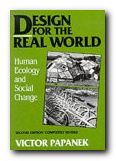human-centred and ecological design principles
Design for the Real World is often tipped in design circles as one of the best overall guides to ethical design theory and practice, along with Donald Norman’s The Design of Everyday Things. Victor Papanek takes a radically user-centred approach to design, with a very strong emphasis on social and ecological consciousness. It’s obvious to see why a book like this becomes a standard text – because all his questions are very fundamental. Essentially, he bases his design judgements on political criteria. What does this object do? Who is it for? What is it made of? And do the answers to these questions have any social consequences for the rest of society?
 He is quite uncompromising in his approach. No objects are too humble to be considered in terms of good or bad design – a hammer, a teacup, even a simple cardboard box. He is amusingly critical of famous design objects such as de Stijl and Macintosh chairs:
He is quite uncompromising in his approach. No objects are too humble to be considered in terms of good or bad design – a hammer, a teacup, even a simple cardboard box. He is amusingly critical of famous design objects such as de Stijl and Macintosh chairs:
These square abstractions painted in shrill primaries were almost impossible to sit in; they were extremely uncomfortable. Sharp corners ripped clothing, and the entire zany construction bore no relation to the human body … The thronelike Glasgow chairs designed by Charles Rennie MacIntosh in 1902 – with six-and-one-half-foot ladderbacks [had] all the soft comforts of an orange crate.
You won’t get lots of ideas for fancy new designs, but you will get a radical method and a critical approach to design which means you will never look at a spoon or a sports car in the same way again.
En route he offers scathing analyses of multinational corporations such as fast food chains and motor car manufacturers for their often selfish and profligate policies. There’s a detailed critique of MacDonald’s packaging waste, and a clear link argued between gas-guzzling car design and US foreign policy in the middle-East. These ideas will appeal to anybody who wishes to combine design with an ecological conscience.
He also comes up with rather witty observations on ‘fashion’ and false aesthetics from time to time:
Because in any reasonably conducted home, alarm-clocks seldom travel through the air at speeds approaching five hundred miles per hour, streamlining clocks is out of place.
As an educationalist, he advances several useful problem solving techniques which could be applied in other disciplines, as well as design. But this book doesn’t let you off the hook. Whatever is being designed, he wants to know ‘Is it useful?’, ‘Does it do the job for which it is intended?’, and ‘Is it cost effective?’
If there’s a weakness, it’s that he spends a lot of time spelling out the problems of people with physical and social disabilities and calling for design solutions to them. We would all agree that these issues need attention, but personally I would rather he explained the principles of good design.
He gives plenty of examples of ‘alternative’ cheap and cheerful design solutions pioneered by his design studio and students
He’s fairly unrelenting in his argument for ecologically sound, labour-saving devices to help the underprivileged of the third world, but few of them seem entirely convincing, even when they pass prototyping.
The latter part of the book takes on the issue of design and education. Here he makes an argument for what he calls integrated design – working in teams, tackling real problems (not fashion-related) and keeping an ethical vision in mind.
The main trouble with design schools seems to be that they teach too much design and not enough about the ecological, social, economic, and political environment in which design takes place.
If you are serious about product design, put this book on your reading list. It’s full of attitude, full of ideas, and uncompromising in its approach. And it’s got a very good series of bibliographies on all topics related to the issues he discusses.
© Roy Johnson 2000
Victor Papanek, Design for the Real World, London: Thames & Hudson, 1985, pp.394, ISBN: 0500273588
More on design
More on media
More on web design
More on information design
